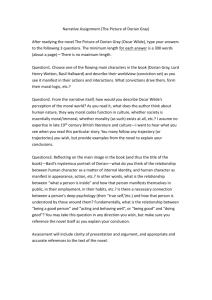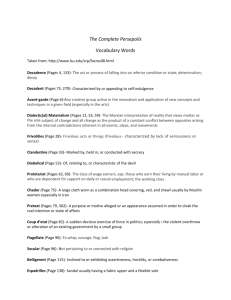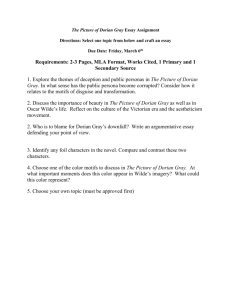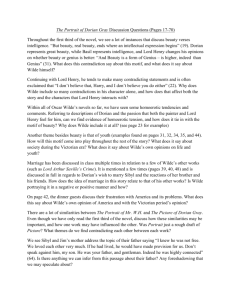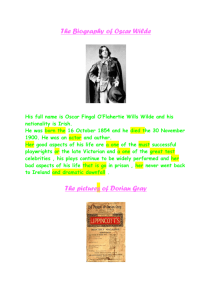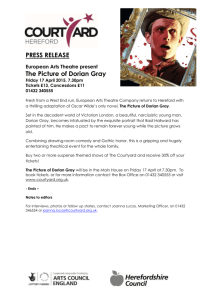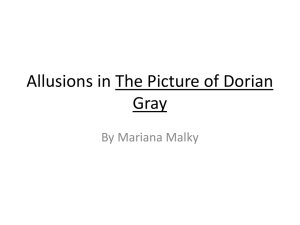Oscar Wilde - BartonHonorsEnglishEckmanFinal
advertisement
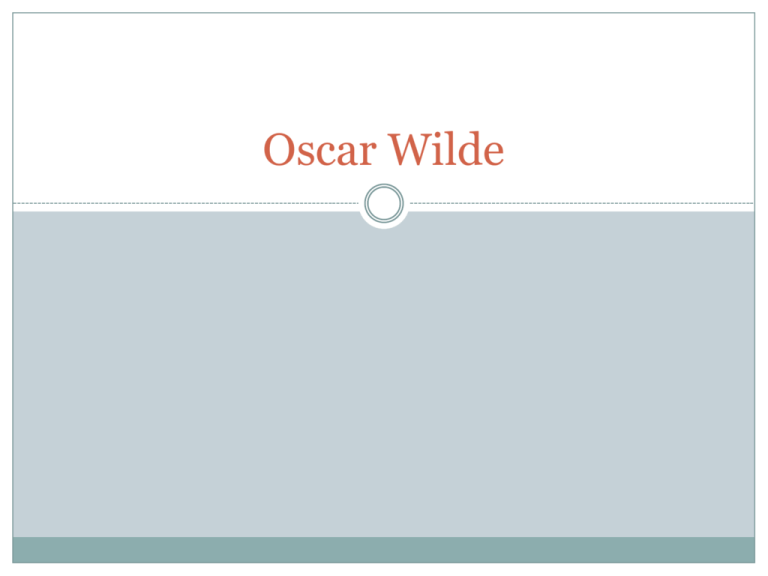
Oscar Wilde Biography Oscar Wilde was born on October, 16 1854 in Dublin, Ireland. His mother was a writer by the name of Jane Francesca Agnes nee Elgee. His father was a surgeon and his name was Sir William Robert Wills Wilde. Oscar also had two siblings. He had and older brother whose name was William and a younger sister named Isola. He was homeschooled until enrolling at Trinity College in 1871. He then went on to further study the classics at Magdalen College from 18741878. After he had gotten out of college he settled down in London and began to write poetry. He had his first poems published in 1881 and they were called Poems. In 1884 he married Constance Mary Lloyd. He had two sons Cyril and Vyvyan. Vyvyan ended up becoming an author while Cyril had died in World War I. Their family had settled in Chelsea, London where Oscar Wilde had continued to write for Pall Mall Gazette a magazine. He also became the editor of Woman’s World in 1887. Then Wilde lived with Lord Alfred Douglas and became very criticized by many people. Wilde later was charged in court for gross indecency. He was sentenced to two years of hard labor. While he was imprisoned, his wife Constance had changed their kid’s last names to Holland. He had then started writing essays, poems, and letters. One of which was written to Alfred Douglas. After he was released in May of 1897 he had written “The Ballad of Reading Gaol” which was about the unfairness of the death penalty and the hanging of Charles Thomas Woodldridge. Wilde had then changed his name to Sebastian Melmoth. Wilde moved to Paris with no money and meet with his Canadian lover Robert Baldwin Ross. He died of meningitis on November 30, 1900. On his deathbed he had been baptized by the Roman Catholic Church, and received Extreme Unction. He was buried in Père Lachaise cemetery in Paris. The Picture of Dorian Gray In the stately London home of his aunt, Lady Brandon, the well-known artist Basil Hallward meets Dorian Gray. Dorian is a cultured, wealthy, and impossibly beautiful young man who immediately captures Basil’s artistic imagination. Dorian sits for several portraits, and Basil often depicts him as an ancient Greek hero or a mythological figure. When the novel opens, the artist is completing his first portrait of Dorian as he truly is, but, as he admits to his friend Lord Henry Wotton, the painting disappoints him because it reveals too much of his feeling for his subject. Lord Henry, a famous wit who enjoys scandalizing his friends by celebrating youth, beauty, and the selfish pursuit of pleasure, disagrees, claiming that the portrait is Basil’s masterpiece. Dorian arrives at the studio, and Basil reluctantly introduces him to Lord Henry, who he fears will have a damaging influence on the impressionable, young Dorian. Basil’s fears are well founded; before the end of their first conversation, Lord Henry upsets Dorian with a speech about the transient nature of beauty and youth. Worried that these, his most impressive characteristics, are fading day by day, Dorian curses his portrait, which he believes will one day remind him of the beauty he will have lost. In a fit of distress, he pledges his soul if only the painting could bear the burden of age and infamy, allowing him to stay forever young. After Dorian’s outbursts, Lord Henry reaffirms his desire to own the portrait; however, Basil insists the portrait belongs to Dorian. Over the next few weeks, Lord Henry’s influence over Dorian grows stronger. The youth becomes a disciple of the “new Hedonism” and proposes to live a life dedicated to the pursuit of pleasure. He falls in love with Sibyl Vane, a young actress who performs in a theater in London’s slums. He adores her acting; she, in turn, refers to him as “Prince Charming” and refuses to heed the warnings of her brother, James Vane, that Dorian is no good for her. Overcome by her emotions for Dorian, Sibyl decides that she can no longer act, wondering how she can pretend to love on the stage now that she has experienced the real thing. Dorian, who loves Sibyl because of her ability to act, cruelly breaks his engagement with her. After doing so, he returns home to notice that his face in Basil’s portrait of him has changed: it now sneers. Frightened that his wish for his likeness in the painting to bear the ill effects of his behavior has come true and that his sins will be recorded on the canvas, he resolves to make amends with Sibyl the next day. The following afternoon, however, Lord Henry brings news that Sibyl has killed herself. At Lord Henry’s urging, Dorian decides to consider her death a sort of artistic triumph—she personified tragedy—and to put the matter behind him. Meanwhile, Dorian hides his portrait in a remote upper room of his house, where no one other than he can watch its transformation. Lord Henry gives Dorian a book that describes the wicked exploits of a nineteenth-century Frenchman; it becomes Dorian’s bible as he sinks ever deeper into a life of sin and corruption. He lives a life devoted to garnering new experiences and sensations with no regard for conventional standards of morality or the consequences of his actions. Eighteen years pass. Dorian’s reputation suffers in circles of polite London society, where rumors spread regarding his scandalous exploits. His peers nevertheless continue to accept him because he remains young and beautiful. The figure in the painting, however, grows increasingly wizened and hideous. On a dark, foggy night, Basil Hallward arrives at Dorian’s home to confront him about the rumors that plague his reputation. The two argue, and Dorian eventually offers Basil a look at his (Dorian’s) soul. He shows Basil the now-hideous portrait, and Hallward, horrified, begs him to repent. Dorian claims it is too late for penance and kills Basil in a fit of rage. In order to dispose of the body, Dorian employs the help of an estranged friend, a doctor, whom he blackmails. The night after the murder, Dorian makes his way to an opium den, where he encounters James Vane, who attempts to avenge Sibyl’s death. Dorian escapes to his country estate. While entertaining guests, he notices James Vane peering in through a window, and he becomes wracked by fear and guilt. When a hunting party accidentally shoots and kills Vane, Dorian feels safe again. He resolves to amend his life but cannot muster the courage to confess his crimes, and the painting now reveals his supposed desire to repent for what it is—hypocrisy. In a fury, Dorian picks up the knife he used to stab Basil Hallward and attempts to destroy the painting. There is a crash, and his servants enter to find the portrait, unharmed, showing Dorian Gray as a beautiful young man. On the floor lies the body of their master—an old man, horribly wrinkled and disfigured, with a knife plunged into his heart. Taken From: http://www.sparknotes.com/lit/doriangray/summary.html The Portrait of Mr. W. H. One story I read by Oscar Wilde was “The Portrait of Mr. W.H.” The story is about Shakespeare’s sonnets. The story starts with him dining with Erskine and talking about forgeries. Then Erskine had asked the narrator if he wanted to hear a strange story of a man who used forgeries to prove a theory. He agreed to hear the story and so the man began to tell him. Then the man started telling the story. He introduced his friend Cyril Graham. He then got up and walked towards a cabinet with two windows. He opened it and inside there was a picture of a man in late sixteen hundred clothes and standing by a table with a hand on a book. The narrator continued to describe the portrait in great detail. Then Erskine told the narrator that it was the portrait of Mr. W. H. Then Erskine gave the narrator a magnifying glass and told him to look at the book. Written on the book was “To the onlie begetter of these insuing sonnets.” The narrator then asked if it was the same Mr. W. H. that Shakespeare had written his sonnets to. Erskine said that his friend Cyril used to think so, and the narrator then started to question the fact that it did not look like Lord Pembroke. Then they began talking about who they believed the sonnets were written to. Erskine then started to tell the story. He first started by describing his friend Cyril Graham in great detail. After he finished describing Cyril he started with the real story. He said one day he got a letter from Cyril and he wanted him to come to his house. When Erskine got there Cyril had told him that he found out who the real Mr. W. H. was. Cyril began by pointing out that whoever was addressed in these sonnets was a big help in his theater. Cyril then started reading sonnets and explaining them. After Cyril is done talking he comes to the conclusion that Mr. W. H. was a young actor in Shakespeare’s theater named Willie Hughes. Erskine then got a telegram from Lord Crediton asking him to dine. Erskine went and Lord Crediton showed him the portrait of Mr. W. H. Erskine then went to Cyril and told him about the portrait. Erskine one day had gone to a printing shop in Holborn. He found some work that he liked and it was done by Edward Merton. He then went to visit Merton and see more of his work. When he arrived he had looked through Merton’s portfolio. In the portfolio is the portrait of Mr. W. H. He asked Merton where he had got it and Merton tried to cover it up but his wife had told Erskine that Merton had done it for Cyril Graham. Erskine went back and started to yell at Cyril for forging a painting to prove his theory. The next morning Erskine found Cyril dead. He had killed himself the night before with a revolver. After he was done telling the story he told the narrator not to investigate the theory. The narrator was committed to finding the truth in this theory. He had studied the sonnets relentlessly. He wanted to prove that Cyril’s theory was the truth behind Shakespeare’s sonnets. The book then drags out him studying all the sonnets and gives you reasons why the theory is true. The narrator sends Erskine many letters to prove the theory. He then goes to meet Erskine but he changed his mind about the theory. When he met Erskine he apologized for sending the letters. Erskine was confused and asked why he had apologized. The narrator then started to tell Erskine that he can’t believe in a theory that’s only evidence is forgery. Erskine then stuck by the theory and would not change his mind no matter what the narrator said. They split up and Erskine went to Germany. A couple years later he had sent the narrator a letter. It said that he was sacrificing his life for the theory just as Cyril did. The narrator went to Germany to try and stop him but when he got there it was too late. He talked to Erskine’s mother and she gave him a picture of Mr. W. H. Summaries of other works Lord Arthur Savile's Crime and Other Stories includes four of Wilde's well-regarded short stories, all of which had been published independently in London periodicals in 1887. In the best-known story of the volume, “Lord Arthur Savile's Crime,” which was originally published in The Court and Society Review, Wilde explores the concepts of fate, duty, and love. Engaged to the lovely and privileged Sybil Merton, Lord Arthur Savile is disturbed when a palm reader informs him that he will commit murder before his marriage. At first rejecting the idea, he eventually becomes convinced that he will have to kill someone before he can marry his beloved. After a few abortive attempts, he encounters the palm reader on an evening walk and throws him into the Thames, thereby fulfilling the fateful prophecy. Years later, Sybil learns that the palm reader was an imposter, but doesn't inform her blissful husband for fear of upsetting him. “The Sphinx without a Secret,” first published under the title “Lady Alroy” in The Court and Society Review in 1887, relates the story of Lord Gerald Murchison and his tragic love affair with the mysterious Lady Alroy. Considered one of Wilde's most successful tales, “The Canterville Ghost” was also published in The Court and Society Review in 1887. When a wealthy, pragmatic American family moves into a haunted English castle, they refuse to believe in the increasingly indignant ghost of Sir Simon de Canterville even as evidence mounts and sightings become more frequent and dramatic. Humiliated, the ghost becomes frustrated by his inability to frighten the Otis family. Eventually, fifteen-year-old Virginia Otis becomes sympathetic to the ghost and resolves to help him attain peace. Her generosity leads to her spiritual enlightenment and financial reward. Initially published in The World, the final story in the collection, “A Model Millionaire,” concerns the generosity of a good-hearted, poor man named Hughie Erskine. When Hughie encounters a disheveled artist's model, he offers him money—only to discover that the man is a millionaire. The next day, he receives an envelope with ten thousand dollars from the millionaire, which allows Hughie to marry his fiancée. Taken From: http://www.enotes.com/oscar-wilde-lord-arthur-saviles-crime-and-other-criticism/lord-arthur-savilescrime-and-other-stories-oscar Symbolism Oscar Wilde used symbolism with The Portrait of Mr. W. H. and the Picture of Dorian Gray. In The Portrait of Mr. W. H. the Portrait is a symbol of forgery. The Picture of Dorian Gray is a symbol of Dorian’s soul. Characterization Characterization is used to introduce and describe a character. An example of characterization in the portrait of Mr. W. H. is when they describe the portrait and how beautiful the man is. Characterization is important because it allows us to see what the author wants us to see. It gives a better understanding of the story and how the characters work within it. A direct example of characterization is "a young man in late sixteenth century costume, standing by a table, with his right hand resting on an open book." because it explains a character in the story. Irony Irony is the discrepancy between what is said and what is meant, what is said and what is done, what is expected or intended and what happens, what is meant or said and what others understand. An example of irony in the story Mr. W. H. is when the narrator tells Erskine that he will not change his theory in the sonnets but he does. Another ironic part in the story is when he Erskine tells him not to study the theory but then he spends the rest of his life in looking for answers. Authors Works Fiction Lord Arthur Savile's Crime The Canterville Ghost The Picture of Dorian Gray The Portrait of Mr. W. H. Non-Fiction A Critic in Pall Mall Plays For Love of the King A Florentine Tragedy: A Woman of No Importance An Ideal Husband La Sainte Courtisane Lady Windermere's Fan Salome The Duchess of Padua The Importance of Being Earnest Vera, or the Nihilists Short Stories The Devoted Friend The Happy Prince The Nightingale and the Rose The Remarkable Rocket The Selfish Giant Poems in Prose The Young King The Birthday of the Infanta The Fisherman and His Soul The Star Child The Sphinx Without a Secret The Model Millionaire Personal Review I thought that the Portrait of Mr. W. H. was quite interesting. The book talked a lot about different theories and it was interesting to read about what people thought about Shakespeare's sonnets and who they were really written to. The Picture of Dorian Gray was very complicated and it took multiple re-reads. Work Cited "Oscar Wilde." - Biography and Works. Search Texts, Read Online. Discuss. Web. 18 Apr. 2012. <http://www.online-literature.com/wilde/>. “Oscar Wilde Lord Arthur Savile's Crime and Other Stories." Enotes.com. Enotes.com. Web. 23 May 2012. <http://www.enotes.com/oscar-wilde-lordarthur-saviles-crime-and-other-criticism/lordarthur-saviles-crime-and-other-stories-oscar>.
